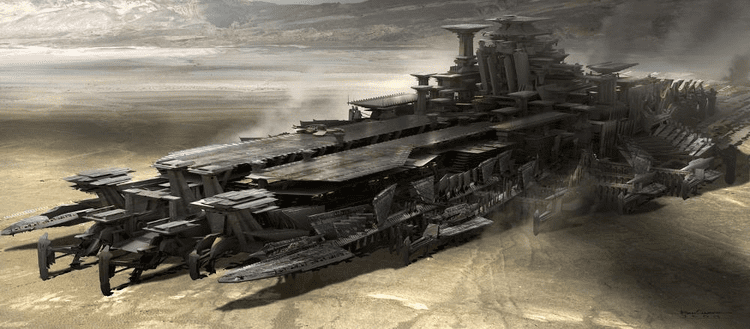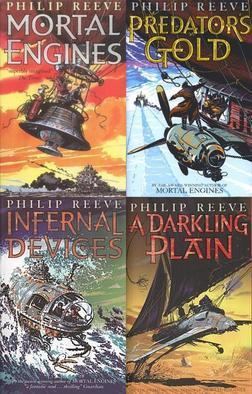Country United Kingdom Publication date 2001–2006 Number of books 4 | Language English Publisher Scholastic Corporation | |
 | ||
Media type Print (hardback and paperback) Cover artists David Frankland, David Wyatt Genres Science Fiction, Steampunk, Post-Apocalyptic fiction Books Mortal Engines, Predator's Gold, Infernal Devices, A Darkling Plain | ||
Predator Cities is the title of a tetralogy, sometimes called the Predator Cities Quartet, consisting of four novels: Mortal Engines (2001), Predator's Gold (2003), Infernal Devices (2005), and A Darkling Plain (2006), written by the British author Philip Reeve. Originally known as the Mortal Engines Quartet, it was known in the United States as the Hungry City Chronicles, over the author's objections to this title.
Contents

Locations

The Mortal Engines Quartet is set in a distant future, known as the Traction Era, in which Earth has been reduced to wasteland by a devastating conflict, known as the Sixty Minute War. Nations no longer exist, except in the lands of the Anti-Traction League; whereas Traction Cities – mobile cities mounted on caterpillar tracks – are fiercely independent city-states, which use giant mechanical jaws to dismantle one another for resources. Trade is mostly accomplished by airship, or between mobile cities of roughly equal size (unable to devour each other). Old-Tech (technology from before the Traction Era, some from the 21st century) is the most sought-after commodity.

ODIN

The Orbital Defence Initiative (abbreviated ODIN) is an orbital satellite weapon; a very powerful remnant of the Sixty Minute War and a major feature of the third and fourth books in the series: Infernal Devices and A Darkling Plain. It was built as part of the arms race between the American Empire and Greater China. It and MEDUSA are the only superweapons known to have survived until the events of the series, although there are several references to other orbital superweapons (Diamond Bat, Jinju 14, and the Nine Sisters for example). ODIN is more powerful than MEDUSA and is able to hit almost any target on the surface of the earth. ODIN is implied an American satellite as the code for controlling the satellite came off an American submarine. The other orbital weapons are hinted to have broken up over time and fallen from the sky.

ODIN is an energy weapon which converts the energy of a small nuclear weapon into a directed beam of incinerating energy (a weapon concept similar to the Strategic Defense Initiative's Project Excalibur). This has the power to exterminate cities (both traction and static) and provoke volcanic eruptions. Its beam can be seen for very long distances and seems to interfere with the mechanical minds of Stalkers. Only Shrike's Old-Tech Stalker brain has the mettle to withstand this, although he goes into a fit-like state and it is hinted he is saved by Dr Oenone Zero. Anna Fang is unaffected. Other Stalkers lose all power.

The Tin Book, copied from a US Military document recovered by the refugees of the original Anchorage from a submarine, is a codebook for controlling ODIN. It is stolen by the Lost Boys and, later, Brighton. It then falls into the hands of the Stalker Fang, who memorises its contents and then leaves it to be destroyed on Cloud 9. It is then destroyed in a fire; when Fang is rebuilt by Fishcake, her Stalker alter-ego travels towards Batmunkh Gompa to firstly steal parts for a transmitter with the power to reach ODIN and then onto Anna Fang's living residence, where there is enough Old-Tech to finish the transmitter. The journey is delayed by Anna Fang's confused and caring personality. At Batmunkh Gompa the Stalker takes control until the final scene.
When ODIN is fired, confusion ensues as both the Green Storm and Traction Cities are targeted. Both sides try to find the transmitter, leading to the Storm's assault of London, but it is Tom, Hester, Shrike and Pennyroyal who find Fang. As Fang prepares to target all the volcanoes on the earth and so destroy humanity, a final confrontation from Tom brings Anna to the fore once more and she orders ODIN to turn its beam weapon upon itself, destroying it completely.
As well as its immensely powerful weaponry, ODIN appears to show signs of intelligence. When it is awakened, it queries its new position and briefly searches for its old masters, and notes the vast difference in geography since its last awakening. It can also zoom in to an individual's face on the Earth and, although the picture is grainy, it is still impressive. It can change its orbit when directed to target all over the globe. This, as well as the Stalker minds found among old-tech (and Shrike) seems to prove that robots had, by the time of the Sixty Minute War, achieved sentience.
Prequel series
The Fever Crumb Series, although released after the Mortal Engines Quartet, takes place centuries or millennia before the events depicted in the Quartet. The main character is Fever Crumb, a London Engineer who is partially descended from the Scriven, a mutant race of humans. The series also introduced the character Shrike, revealing his origins before he became a Stalker.
The Fever Crumb series also visits many of the locations not depicted in the Mortal Engines Quartet.
Names
A few of the people in the books are named after places in Devon, where Reeve lives, including Chudleigh, Tamerton Foliot and the River Plym. In the quartet, Miss Plym and Chudleigh Pomeroy are both in the Guild of Historians, and Tamarton Foliot is an "Alternative" historian. Both Shrike and Smew are named after birds, and Pennyroyal is named after a flower.
Many of the characters are named after ancient (in the context of the books) brands: Windolene Pye, Daz Gravy, Nutella Eisberg, Napster Varley, and Nabisco Shkin for example.
Friends of Phillip Reeve are also occasionally mentioned in the books; for instance 'Poskitt' is included as a god, clearly referring to Kjartan Poskitt, a friend and the author of books that Reeve has illustrated in the past.
Traction Cities
Some Traction Cities bear present-day names, but some, such as Airhaven and Motorpolis, are invented. All Traction Cities consist of several 'tiers' fixed to a huge hull containing engine rooms, storage hangars, and a large 'gut' where captured towns are dismantled. At the sides are enormous tracks or wheels; and huge hydraulic 'jaws' at the bows to capture smaller towns. Various names are given below:
Airship names
Airships in the quartet carry unusual or quirky names reminiscent of the style of the names of ships in Iain M. Banks' Culture series.
Films
In 2009, Peter Jackson, director of the Lord of the Rings trilogy, expressed interest in directing the film adaptations. As it is early in production, not much is known of it. Currently WETA is said to be working on the designs for the first book. It is rumoured that they've been sitting on the rights for some time. There have been previous attempts to adapt Mortal Engines, but Philip Reeve declined the offers, as he was afraid that they would change the book too much. In October 2016, it was announced that Jackson will produce the film and second unit director Christian Rivers will direct. Production is to begin the first quarter of 2017 for a December 2018 release.
Comic
Philip Reeve has also mentioned the possibility of a comic set in the world of Mortal Engines. He said that he has been discussing it with David Wyatt and mentioned that a younger Anna Fang would be an interesting character to focus on. However, it is unknown whether it will be finished or not.
